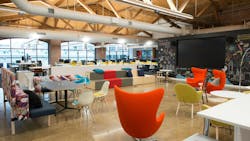From Guesswork to Green Work: How Occupancy Intelligence Helps Meet ESG Goals
In the pursuit of reducing your carbon footprint and meeting your environmental, social, and governance (ESG) goals, you probably switched to energy-saving light fixtures, launched recycling programs, sourced from green suppliers, and calculated the carbon impact of air travel. And yet, your goals remain out of reach even while your workplace changes.
Over the last five years, workplaces have transformed from traditional, single-purpose offices into flexible, hotel-like environments—and then branched into countless variations. As companies broaden their sustainability goals to include greater efficiency, occupancy intelligence has emerged as the key to designing workplaces that are both eco-friendly and optimized for productivity.
Data is one of the most powerful tools for driving meaningful changes that support your ESG goals. By leveraging real-time occupancy data, organizations can adjust their spaces, policies, and design to better align with employee needs and culture. In turn, these data-driven insights enable more strategic decisions about lighting, resource allocation, and maintenance, propelling sustainability goals forward faster.
Technological Advancements
Advances in sensor technology allow organizations to collect, analyze, and make data-driven real estate and workplace decisions. As sensors become smaller and more energy-efficient—particularly with wireless models boasting a decade or more of battery life and simple, set-and-forget installation—collecting occupancy data no longer needs to be a major financial or logistical hurdle.
At the same time, the shift toward battery-powered sensors challenges commonly held assumptions about environmental impact. Once seen as a barrier to sustainability, advancements in battery technology empower manufacturers to design sensors that run on minimal energy, ensuring long-term reliability on a single set of batteries. These innovative solutions match the performance of their wired counterparts without drawing additional power from the grid, significantly shrinking their overall environmental footprint, and sometimes making them an even more sustainable solution than their wired counterparts.
Meeting Employee Needs, Too
What’s the point of a more efficient workplace if it drives people away? Focusing purely on cutting costs could lead to cramped seating and poor lighting, ultimately undermining productivity and causing employees to seek employment elsewhere.
Truly sustainable solutions must be a win-win, balancing efficiency with employee well-being. Occupancy data helps organizations find that sweet spot, offering inviting collaborative areas alongside quiet work zones while still reducing the overall carbon footprint. It’s a reminder that sustainability isn’t just good for the environment—it’s good for business, too.
With a 20-million-square-foot portfolio spanning over 4,000 leases, Deutsche Bank understands how much sustainability impacts operations—and employees. In a recent webinar, Antonio Brunner, Global Head of Projects, described the importance of embracing bold, tech-driven strategies to optimize building operations. He credits occupancy intelligence—the practice of using sensors, software and analytics to collect and analyze data about how people use physical spaces in order to make more informed decisions—for helping the company accelerate its progress toward net zero, among other operational gains. Brunner explained how they can dynamically adjust heating, cooling, and ventilation based on real-time usage and optimize cleaning schedules, both resulting in significant cost savings while maintaining employee comfort.
Benefits for Companies of All Sizes
A global company’s success with sensor technology might suggest that only large organizations can leverage occupancy data for sustainability and workspace optimization. In reality, advances in sensor technology make these insights accessible to companies of any size—you just have to get started.
Begin by measuring your current conditions to establish a benchmark, then expand wherever more clarity or decisions are needed. Thanks to wireless, lightweight sensors, you can now pilot the technology on a single floor or in a specific area without the cost and disruption of extensive wiring or major renovations. Once you see how it works, scaling up is straightforward.
This modular approach suits organizations still refining their work policies and space design. There’s no need to overhaul your sustainability story overnight; instead, take one step at a time, and allow the data to guide you.
Measurable Results, Meaningful Impact
Small operational changes can create a substantial impact on both costs and sustainability. Deutsche Bank reported saving more than 30% in energy on certain days—without sacrificing employee comfort—thanks to occupancy data. These results wouldn’t have been possible by following sustainability practices of the past.
Today’s advanced sensor technology empowers any organization to move the needle on efficiency and environmental goals. With real-time, data-driven insights, companies can make informed decisions that benefit employees while safeguarding the planet.
About the Author
Kelby Green
Kelby Green serves as the CTO of VergeSense, the leader in Occupancy Intelligence. In 2017, Dan Ryan and Kelby Green founded VergeSense to unlock the potential of every space to foster connection, inspiration, and sustainability.
